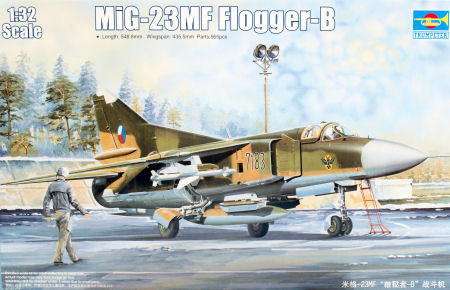
Trumpeter 1/32 MiG-23MF Flogger B Kit First Look
by Michael Benolkin
| Date of Review | May 2010 | Manufacturer | Trumpeter |
|---|---|---|---|
| Subject | MiG-23MF Flogger B | Scale | 1/32 |
| Kit Number | 3209 | Primary Media | Styrene, photo-etch, white metal |
| Pros | First styrene kit of this subject in this scale; very nice detailing throughout | Cons | See text |
| Skill Level | Experienced | MSRP (USD) | $169.95 |
First Look
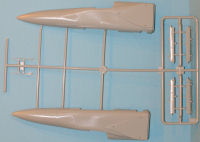 |
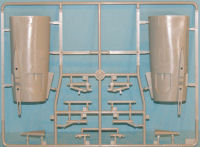 |
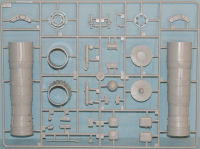 |
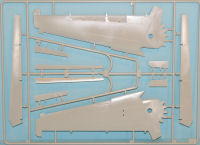 |
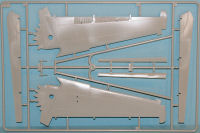 |
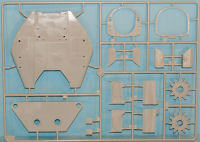 |
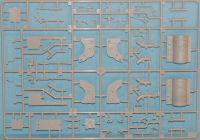 |
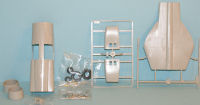 |
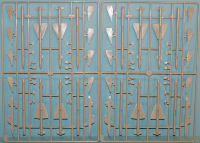 |
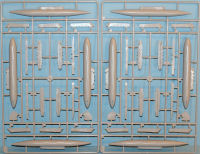 |
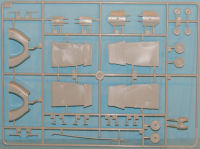 |
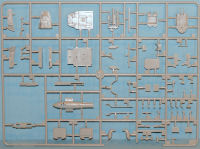 |
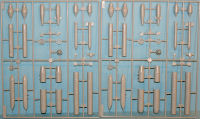 |
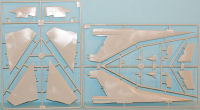 |
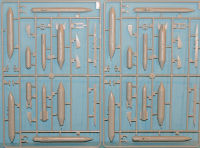 |
 |
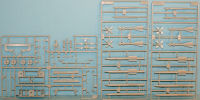 |
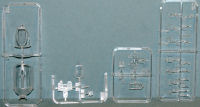 |
 |
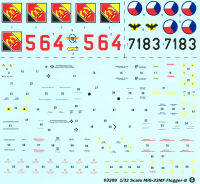 |
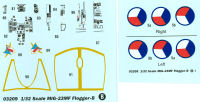 |
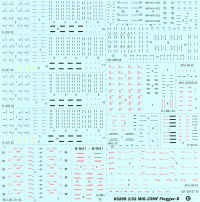 |
The MiG-23 series marked the beginning of the generation three fighters on the Soviet side and represented a major advance over previous Soviet designs. Built from the outset to operate from forward area locations, the aircraft had rugged landing gear to allow operations from bare fields and battle-damaged runways. The MiG-23 was the first Soviet design to employ full span moving wings (the Su-17 also had moving wings, but the inboard sections of the wings were fixed). The R-29 engine had significant power improvements over previous generations and could move the MiG-23 swiftly up to Mach 2.2+ at altitude.
The design of the MiG-23 is graceful in its execution as it incorporated numerous features found on other designs from around the world. The fuselage and swept wing design is similar to the Mirage G8. The high-mounted wing gloves allowed for the placement of larger weapons on a fixed portion of the structure to eliminate the complexity of pivoting wing pylons as used on the F-111 and not used on the F-14. The side-mounted intakes bear a strong similarity to the F-4 Phantom II with the splitter plates so similar that they have the bleed air holes in the plate as well as the three cable cutter bars between the splitter plate and the fuselage on each side.
The MiG-23 was developed around the Saphir-23 radar and R-23 missiles purpose-built for the aircraft. Unlike the early radar-equipped MiG-21s, the MiG-23 was armed with a cannon system in every operational variant. It could also employ a variety of other weapons still in service from the MiG-21 in the air-to-air role as well as a variety of 'standard' rockets and bombs for the air-to-mud role. While there were several variants of the MiG-23 that were purpose-built for air-to-ground missions with the MiG-23B/MiG-27 series 'Utkanos' (duck nose), most fighter aircraft that were no longer on the leading edge of air superiority were also relegated to the mud-moving mission.
Here is the first installment in Trumpeter's long-awaited Flogger family - the MiG-23MF Flogger B. The MiG-23MF was the export version of the Flogger B with a few minor capabilities removed for Warsaw Pact and 'allied' use. When I first saw the sprue shots over on the IPMS/Philippines website, I was excited as this is the first serious attempt at a MiG-23 in anything larger than 1/72 scale in many decades. For the longest time, the only Flogger options we had in styrene were the Hasegawa 1/72 Flogger B and Flogger D kits (which weren't really bad); and the ESCI/ERTL 1/48 Flogger B and Flogger D kits that were re-boxed Hobbycraft and Italeri (which weren't so hot). These latter kits were fun kits to build but had numerous issues that were difficult to fix. Several companies have more recently tackled the 1/72nd scale with offerings, but as I said, this kit is the first of many that will address the larger scales and is the first of its kind in 1/32 scale styrene.
Molded in light gray styrene, this kit is presented on 28 (!!) parts trees plus four trees of clear styrene parts, one set of rubber tires, one fret of photo-etched details, one set of white metal landing gear strut cores, and a handful of separately packaged gray styrene parts. If you look through the styrene trees, you can see the future of this kit family with some of the unique variants sharing space on these same parts trees. Cool!!!
So let's get to the features:
- At first blush, the kit features a nicely detailed KM-1M ejection seat, but it is missing the bottom portion that is the survival kit that the pilot sits upon. You'll have to go to an aftermarket seat and there are plenty available
- Nice looking cockpit that captures the shape and layout of the front office. The only thing missing here is the throttle handle which is VERY easy to fabricate and attach to the slide mechanism correctly molded into the left side wall
- Positionable canopy
- Nose gear strut effectively captures the details of the full-scale strut down to the water shields and photo-etched reinforcements
- The splitter plates are interesting as they've captured the three cable cutters between the fuselage and plate, plus added a section of photo-etch to replicate the perforated look of the boundary layer holes
- Positionable suck-in doors on the intakes
- Positionable leading edge and trailing edge flaps
- Positionable spoilers
- Positionable stabilators
- Positionable rudder
- Positionable speed brakes
- Positionable ventral fin (only goes down when the landing gear comes up)
- Synchronized (geared) movable wings BUT mount the flaps up and the spoilers down or you will be sorry
- Nicely detailed main gear wells though it looks like it is missing the Soviet and NATO-styled single-point refueling ports
- Nicely detailed main landing gear struts (note that you'll have to modify these to an un-weighted angle if you pose the aircraft in-flight with the gear down as these look really different in flight - check your references)
- Intake ducts back to the engine face
- Gorgeous R-29 engine
- Removable tail section to reveal that engine
- Choice of open or closed afterburner nozzles
- Very nicely detailed GSh-23 gun pack that looks to be removable to reveal the ammo pack
- Optional tail section cart
A couple of interesting 'glitches' in the kit:
- KM-1M ejection seat is missing the seat bottom. There is no kit part for the survival pack/seat bottom that goes into the seat pan of the ejection seat
- The ventral folding fin is portrayed in the instructions as a smaller fixed ventral fin. The kit fin is hinged and is fine as-is
The design of the kit is modular so you will be seeing some interesting variants coming in the future. One of those variants that have some of their unique parts in this kit include:
- MiG-23ML Flogger G - instrument panel and IRSTS are in this kit
One of the other major features also in this box is the array of armament. I've seen some speculate that these sprues are out of their 1/32 Russian Aircraft Weapons set, a quick look here will set that rumor straight. All of these weapons sprues are either new or perhaps shared out of the MiG-21 kits. What we have for external stores options include:
- APU-23 wing glove pylons
- 1 x R-23R (AA-7 Apex) radar-guided missile
- 1 x R-23T (AA-7 Apex) IR-guided missile
- 1 x R-24R (AA-7 Apex) radar-guided missile
- 1 x R-24T (AA-7 Apex) IR-guided missile
- 4 x R-13M (AA-2 Atoll) IR-guided missiles
- 4 x R-13M1 (AA-2 Atoll) IR-guided missiles
- 4 x R-3R (AA-2 Atoll) radar-guided missiles
- 4 x R-60 (AA-8 Aphid) IR-guided missiles
- 2 x Kh-23M (AS-7 Kerry) missiles
- 2 x RB-250 bombs
- 2 x RBK-250 bombs
- 2 x RBK-500 bombs
- 2 x UB-32-57 rocket pods
- 2 x B8M1 rocket pods
- 2 x S-24B 240mm rockets
- 2 x UPK-23/250 gun pods
- 1 PTB-800 centerline drop tank
- 2 x under-wing ferry tanks (these do not pivot)
With this armament line-up, you can easily represent this MiG-23MF in any Warsaw Pact or allied colors, and with a little tweaking of some airframe details, render the MiG-23M in Soviet service as well.
One question I get is about that folding fin under the tail. Whenever the landing gear is down, that fin is folded. To avoid the possibility of landing with that fin deployed, the MiG designers put that fin system on the landing gear switch. Gear up/fin down, gear down/fin up.
The kit provides two distinctive subjects:
- MiG-23MF, Bort 564, JG 9, East German Air Force/Air Defense
- MiG-23MF, Bort 7183, 1st Fighter Air Regt, Czech Air Force
Evidently someone saw one of the early test releases of this kit and as you'll see in the first decal image, all of the Czech markings are the same (they should be handed for proper orientation on the left and right-sides of the aircraft). Trumpeter took that information and added a correction set in this boxing to properly render the Czech national markings.
The first decal sheet also has an extensive set of maintenance stencils as the distinctive markings of these aircraft were kept to a minimum in most cases.
The bottom image shows the extensive set of weapons and pylon stencils also included in this kit. The decal image in the center shows something I've never seen before - decals to represent the sealant used to mount the transparent panels to the canopy and windscreen frames. This will add some nice visual enhancements to the canopy without the extra masking. Kudos to Trumpeter for this innovation!
The Future
With the modular design of this kit, I don't know how many variants Trumpeter will eventually release, but with some careful parts swapping, most of the variants can be built with the tooling completed by Trumpeter. With the exception of the two-seat Flogger C and the small-nosed Flogger E, it looks like the rest of these aircraft can be rendered with the parts previewed. Here's a look at the key features of the Flogger family and while there are a few exceptions to every list, it gives you a look at the parts swaps to render the MiG-23/MiG-27 series:
| MiG-23/27 Flogger | B | C | D | E | F | G | H | J | K |
|---|---|---|---|---|---|---|---|---|---|
| Single Seat | X | X | X | X | X | X | X | X | |
| Two-Seat | X | ||||||||
| Large Radome | X | X | X | ||||||
| Small Radome | X | X | |||||||
| Duck Nose | X | X | X | X | |||||
| F-4 Splitter Plates | X | X | X | X | X | X | X | ||
| Small Splitter Plates | X | X | |||||||
| Two-Frame IRSTS | X | ||||||||
| Three-Frame IRSTS | X | X | |||||||
| GSh-23 Cannon | X | X | X | X | X | X | X | ||
| Gatling Gun | X | X | |||||||
| Large A/B Nozzle | X | X | X | X | X | X | X | ||
| Short A/B Nozzle | X | X | |||||||
| Long Tail Fillet | X | X | X | X | X | X | X | ||
| Short Tail Fillet | X | X | |||||||
| R-23/24R Apex | X | X | X | ||||||
| R-23/4T Apex | X | X | X | X | X | ||||
| R-60 Aphid | X | X | X | X | X | X | X | X | X |
| R-13 Atoll | X | X | X | X | X | X | X | X | X |
| R-27R/T Alamo | X | ||||||||
| R-73 Archer | X | ||||||||
| R-77 Adder | X |
In the case of the missiles, most of the weapons listed here are in the Flogger box. The latest weapons like Archer and Adder can be found in the previously mentioned Soviet Weapons Set mentioned earlier, or you can use Zactoman's beautiful resin missiles done for the MiG-29 and Su-27 series for the MiG-23MLD Flogger K when it comes out.
Most of the differences between Soviet/Russian service aircraft and their export counterparts showed up in the antenna details. If you look at your references, you'll see a few extra antennas on the domestic aircraft that aren't typically there on the export aircraft. Also note that the IFF antennas were all the three-dipole 'Odd Rods' antennas in the early days and were eventually replaced or augmented with updated small blade antennas later in service. You'll see a variety of configurations depending on the year your reference photos were taken.
I can't tell you how pleased I am to see this kit. It is even better in person that the images I'd previously seen and I already have another on order for a special project coming up. I am very much looking forward to the other Flogger variants as this is one of my favorites. Trumpeter has done a nice job with this tooling and I am looking forward to seeing if this builds up as nicely as it looks.
My sincere thanks to Stevens International for this review sample!







